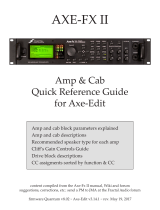Page is loading ...

Professional Power Amp Design
With all the power amp classifications, there may be terms you are unfamiliar with, so this document contains a
brief description of Carvin's professional power amplifier designs and terminology. First, power amps have two
basic components, a) the POWER SUPPLY which supplies the voltages and current to the amp, and b) the
AMPLIFIER itself with inputs, outputs and level controls. It is the final output stage of the amplifier that
determines its Class. However, before explaning the different amp classes, one needs to understand the
differences between power supplies, since that is what powers the amp. The type of power supply has nothing to
do with an amplifier's class; that is determined by the design of the amp itself.
POWER SUPPLY
1) The first power supplies, starting in the 1930s, used IRON CORE transformers to raise
or lower AC voltages, which were rectified (converted) into DC voltages for the
amplifier. These iron core transformers were quite heavy, primarily due to the weight of
the core.
2) Next came TOROIDS in the 1990s, which used iron cores
also, but were more efficient because the primary (incoming) and
secondary (output) wire were layered next to each other on an
iron ring. This more efficient design resulting in saving weight
versus iron core transformers.
3) The latest technology is the SWITCHING POWER SUPPLY.
This too was available in the 90s, however, it was limited to
smaller power applications. Today the advantage of a switching
supply is its light weight - nearly 90% reduction and better
regulation for the amplifier. High frequencies of 100,000 Hz or greater no longer required
the heavy iron core along with the many turns of copper wire, which added resistance,
causing heat. However, while switching supply technology is a great breakthough to
produce lightweight amps, many of these amps do not deliver their rated RMS power because of their design.
Typical complaints can be there is not enough bottom-end. Even toroid power supplies (non-switching) had this
problem too. Here's why:
Typical Iron Core Transformer
Typical Toroid Transformer
Switch Mode Transformer

KICK DRUM TEST
The kick drum test will demonstrate in Chart #3 that
the typical lightweight amp will deliver its full
power for the 1st kick of 20mSec. However, when
the 2nd kick comes there is sag in the voltage /
current, and the amp cannot reproduce the full kick.
The reason is these switching supplies are not built
to "linear power" specifications and their voltages /
current sags. Generally these lightweight amps cost
less to build because of smaller capacitors, fewer
output devices and smaller heat sinks. For the most
part these typical lightweight amps satisfy the light
users, but not the pros who have used these amps
and hear the lacking bottom-end at high power
levels.
If you look at Chart #2, you'll see the Carvin DCML
power amps maintain their reserve voltage/current to
faithfully reproduce Chart #1 delivering the full 2nd
beat of the original kick drum signal. This demonstrates the DCML high damping factor for instantaneous
voltage/current. The Carvin SwitchMode Technology™ power supplies are not only designed for 100% "on-
demand" voltage / current of a linear power supply but they also feature autoswitching from 120V 60 Hz to
240V 50 Hz.
AMPLIFIER CLASS
1) CLASS A/B is a conventional linear amplifier. It could be tubes, FETS (field effect transistor), or bi-polar
transistors it's all the same CLASS A/B. In more technical terms, a CLASS B amp does not draw current until
there is a signal. The problem with CLASS B is that distortion can be introduced during the time when the
output voltage crosses zero. CLASS A draws current continuously even if there is no signal - a huge power
supply is required and it runs hot. The combination of CLASS A/B eliminates the distortion of CLASS B by the
help of the CLASS A idle current.
DCM MODELS: DCM1540L, DCM2000L
2) CLASS A/B TRACKING is identical to the CLASS A/B amplifier in the original DCM series but how the
high voltage is applied to the amplifier is different. This design introduces a third section that interfaces the
power supply to the amplifier. The voltage from the power supply is adjusting to what is needed to produce the
output wattage demanded by the input of the amplifier. This section keeps the high voltage very low on the
amplifier until it sees a need to raise it up. The voltage tracks the input signal and the rail voltage is adjusted as
necessary, which is why it's called CLASS A/B TRACKING. The primary advantage is to use less power, thus
removing heat from the chassis.
BASS AMPS: B2000
DCM MODELS: DCM3000L, DCM3800L

3) CLASS D is a totally different amplifier, which is called a "switching amplifier". Carvin CLASS D
amplifiers incorporate both a "switching power supply" and a "switching amplifier", which saves a considerable
amount of weight and power. The CLASS D output features a high frequency switching signal, which is a
500,000Hz square wave. This is modulated with an input audio signal and then rolled off to produce a linear
high power audio output. The advantage of CLASS D is its 94% efficiency eliminating heat and substantially
reducing the AC line power requirement.
BASS AMPS: BX500, BX1500
DCM MODELS: DCM1000L, DCM2000L (Feb 2010 model), DCM2004
MIXERS: XP800L, XP1000L, RX1200L, C1648P
CLASS SUMMARY:
While Class A/B has been the standard for years, Class D has the advantage of being more efficient. Both
classes sound great and the RMS equivalent is the same for either Class. However, the THD (distortion) output
of a Class D amp will change according to its output impedance. Example: 8 ohms: .08%, 4 ohms .1%, and 2
ohms .25%. Typically, you would not hear any difference between 2 or 4 ohms especially for subwoofers so the
operation efficiency of Class D can become more important than the THD difference.
CONCLUSION:
Carvin's Class A/B and Class D power amps and mixers are engineered to the highest
standards to provide years of quality performance. Continuous full power is assured
from high-grade 6063-T5-aluminum heat sinks and high-current components. Heavy-
duty connectors provide a positive connection to your cables, ensuring every watt gets
to your speakers. Carvin's "SMT" Surface Mount Technology utilizes surface mounted
components to prevent parts from shaking or vibrating loose, and precision 1%
tolerances guarantee your settings will be accurate every time. Fire retardant FR-4
military spec circuit cards feature double-sided copper to guard against noise and radio
frequencies (RF) interference. Carvin's power amps and mixers are made in the USA,
and will provide excellent sound and performance for years.
High current components & FR4
fire retardant circuit card
/



